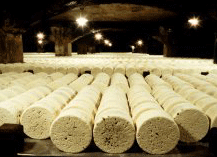Things to do in the Languedoc: Food: Regional Specialities: Cheeses
|
  Roquefort. The
famous blue cheese made from Ewe's milk. 22,000 tonnes
are produced each year in cool natural caves. The blue-green
veins are spores of microscopic mushrooms (penicillium
roqueforti). Local villagers have enoyed exclusive
rights since King Charles VI granted them in 1407. Roquefort. The
famous blue cheese made from Ewe's milk. 22,000 tonnes
are produced each year in cool natural caves. The blue-green
veins are spores of microscopic mushrooms (penicillium
roqueforti). Local villagers have enoyed exclusive
rights since King Charles VI granted them in 1407.
Roquefort is a blue cheese: probably the most famous
of all cheeses in the world. European law dictates that
only those cheeses aged in the natural Cambalou caves
of Roquefort-sur-Soulzon may carry the name Roquefort,
as it has a protected designation of origin (AOC). Roquefort
is sometimes known as the "King of Cheeses".
Roquefort is not Pasteurised. It takes 3 months to age,
and has had AOC certification since 1925.
|
|
|
  The
cheese is white, crumbly and slightly moist, with veins of
blue mold. It has no rind. It has characteristic odour and
flavour with a taste of butyric acid. The blue veins provide
a sharp tang. The overall flavour sensation begins slightly
mild, becomes sweet, then smokey, then fades to a salty finish. The
cheese is white, crumbly and slightly moist, with veins of
blue mold. It has no rind. It has characteristic odour and
flavour with a taste of butyric acid. The blue veins provide
a sharp tang. The overall flavour sensation begins slightly
mild, becomes sweet, then smokey, then fades to a salty finish.
A typical wheel of Roquefort weighs between 2.5 and 3 kilograms,
and is about 10 cm thick. As each kilogram of finished cheese
requires about 4.5 litres of milk, Roquefort is high in fat,
protein and minerals, especially calcium.
  The
mold that gives Roquefort its distinctive character is found
in the soil of the local caves. Traditionally the cheesemakers
extracted it by leaving bread in the caves for six to eight
weeks until it was consumed by the mold. The interior of the
bread was then dried to produce a powder. Nowadays the mold
can be produced in a laboratory, which allows for greater
consistency. The mold may either be added to the curd, or
introduced as an aerosol, through holes poked into the cheese. The
mold that gives Roquefort its distinctive character is found
in the soil of the local caves. Traditionally the cheesemakers
extracted it by leaving bread in the caves for six to eight
weeks until it was consumed by the mold. The interior of the
bread was then dried to produce a powder. Nowadays the mold
can be produced in a laboratory, which allows for greater
consistency. The mold may either be added to the curd, or
introduced as an aerosol, through holes poked into the cheese.
  Roquefort
is made from the milk of the Lacaune breed of sheep. It is
produced throughout the département of Aveyron and
part of the nearby départements of Lozère,
Gard,
Hérault
and Tarn. This area of France is notable for its limestone
geology, which determines what species of grass and wildflowers
grow upon it, which in turn influences the taste of the milk. Roquefort
is made from the milk of the Lacaune breed of sheep. It is
produced throughout the département of Aveyron and
part of the nearby départements of Lozère,
Gard,
Hérault
and Tarn. This area of France is notable for its limestone
geology, which determines what species of grass and wildflowers
grow upon it, which in turn influences the taste of the milk.
As of 2003, there are seven Roquefort producers. The largest
by far is Roquefort Société made by the Société
des Caves de Roquefort a subsidiary of Lactadis) , which holds
several caves and opens its facilities to tourists. Roquefort
Papillon is also a well-known brand. The five other producers,
each holding only one cave, are Carles, Gabriel Coulet, Fromageries
occitanes, Vernières and Le Vieux Berger.
Roquefort, or similar style cheese, is mentioned in literature
as far back as Roman
times. In AD 79 Pliny the Elder remarked upon its rich flavour.
Cheesemaking colanders have been discovered among the region's
prehistoric
finds.
Crotin de Chèvre. Tasty goat's cheese.
Tomme de Lozère and Tommedes Pyrénées: Cheeses
made from cow's milk.
Pélardon. AOC goat's cheese. Produced
from the Cévennes
to the Black Mountain and from the Hautes Corbières
to the Herault and scrublands of the Gard.
Perail. Tasty goat's cheese. (Crotin
de Chèvre)
Tielle. Round cheese from Sète.
The French have extraordinarily complicated rules about how
to cut cheeses - different rules for each type. You cannot
possibly be expected to know them all, but you will not gofar
wrong if you follow the basic rule about taking your fair
share of the rind, and a secondary one which is to leave,
as far as possible, the remaining cheese in the same shape
as it was before you cut it.
|

![]()










